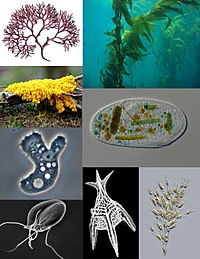
Photo from wikipedia
Chrysophytes are a diverse group of protists belonging to the Stramenopiles. They encompass a broad range of nutrition strategies (phototrophy, mixotrophy and heterotrophy) and morphological forms (unicellular, colonial, branched, non-scaled… Click to show full abstract
Chrysophytes are a diverse group of protists belonging to the Stramenopiles. They encompass a broad range of nutrition strategies (phototrophy, mixotrophy and heterotrophy) and morphological forms (unicellular, colonial, branched, non-scaled to silica-scaled). However, taxonomy, identification and delineation of genera and species are hampered by the polyphyletic origin of several morphotypes and the low resolution of morphological features; moreover, description of these features requires in many cases special equipment like TEM or SEM. To test the congruent phylogeny, genetic resolution and to reveal the genetic diversity of chrysophytes, we evaluated in this study different gene markers, in particular SSU and LSU rRNA genes, ITS, and COI in terms of phylogenetic clustering, separation of phylogenetic lineages and genetic distances within and between clades. Our results showed that the general topology of the SSU rRNA gene phylogeny is similar to that of the LSU rRNA gene phylogeny, with a higher genetic divergence for the latter. The topology of the COI phylogeny differed from the ribosomal data, and showed the highest genetic divergence within groups and between groups for all compared markers. The 5.8S rRNA gene offered only a limited phylogenetic resolution with low genetic divergence. ITS showed a high genetic divergence, but phylogenetic analyses were hampered by high variance in sequence lengths between clades.
Journal Title: Fottea
Year Published: 2017
Link to full text (if available)
Share on Social Media: Sign Up to like & get
recommendations!